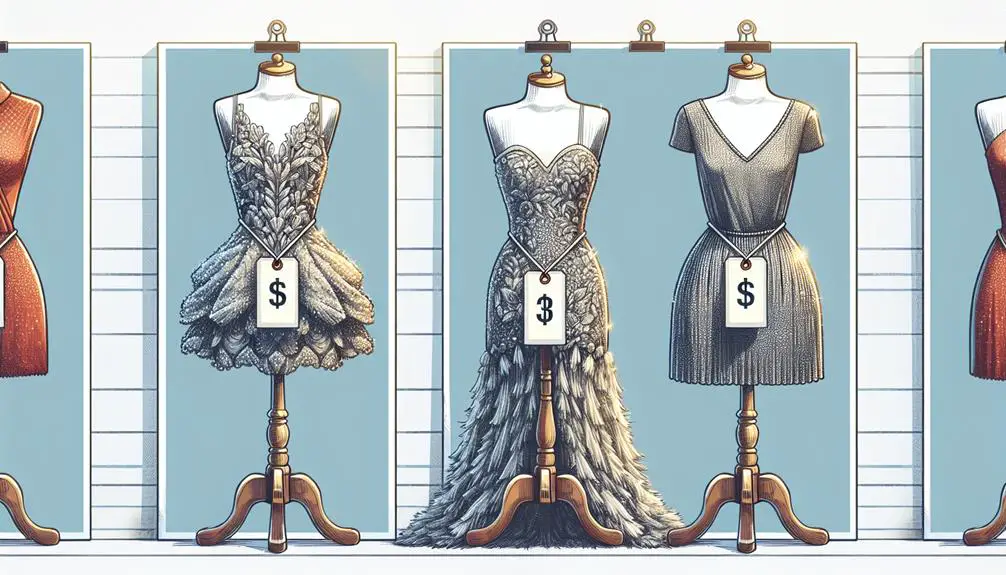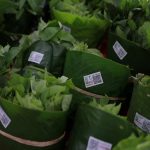I've been pondering over the cost of rayon lately, and it's quite the riddle. On one hand, it's touted as this affordable alternative to luxe fabrics like silk, giving off that high-end vibe without emptying your wallet. But then, you dive into the nuances—types of rayon, production methods, and all that jazz—and suddenly, the price tag isn't as straightforward. It makes me wonder, is rayon genuinely cost-effective, or are we overlooking hidden expenses that might tip the scale? There's more to this than meets the eye, and I'm keen to unravel the mystery.
Table of Contents
Key Takeaways
- Rayon is considered a budget-friendly fabric, offering a high-end vibe at a lower price point compared to silk or cashmere.
- The cost of rayon can vary due to factors like raw material quality, production techniques, and brand reputation.
- Certain types of rayon, such as modal and lyocell, can be more expensive due to eco-friendly and sophisticated manufacturing processes.
- Despite its affordability, care and maintenance costs, including dry cleaning, can add to the overall expense of owning rayon garments.
- Rayon's price competitiveness with luxury materials hinges on its quality variations, with higher quality rayon commanding higher prices.
Understanding Rayon Fabric
Rayon's got a rep for being a go-to fabric when you're on a budget, but there's more to it than just its price tag. See, the thing about rayon is that it's kind of a chameleon in the fabric world. It's made through a pretty interesting process where they take plant pulp and put it through chemical treatments to whip up fibers. This isn't your grandma's cotton or silk – it's like the sci-fi version of textiles.
What's cool is that rayon can mimic the look and feel of more luxurious fabrics like silk, but without making your wallet cry. It's like getting that high-end vibe for less, which is why I'm all over it for my wardrobe. But, it's not all sunshine and rainbows. Despite being budget-friendly and looking posh, rayon demands a bit of pampering. We're talking special care, like sometimes needing dry cleaning, which, I'll admit, is a bit of a hassle.
Still, its versatility and price point make rayon a popular choice for all sorts of clothing. From your everyday tees to those fancy dresses you save for special occasions, rayon's got you covered, literally.
The Cost of Producing Rayon
So, let's chat about what goes into making rayon and why its price tag looks the way it does.
We're talking raw material costs, the nitty-gritty of the manufacturing process, and how caring for the environment tacks on extra bucks.
It's a mix that makes rayon's cost kind of a balancing act, and I'm here to break it down for you.
Raw Material Prices
Diving into how much it costs to make rayon, the price of raw materials like wood pulp or bamboo really sets the stage. Here's the lowdown:
- Raw Materials: The cost of wood pulp and bamboo can swing a lot, affecting rayon's price tag.
- Fluctuations: These price swings mean the cost of producing rayon can jump around too.
- Economies of Scale: Making more rayon can lower costs per unit, thanks to production efficiency.
- Quality Matters: Better raw materials boost rayon quality but push up prices.
Manufacturing Process Complexity
The process of making rayon's no simple task; it's packed with complex chemical steps that ramp up the cost. Dive into rayon production, and you're looking at a series of intricate chemical treatments. We're talking sodium hydroxide, carbon disulfide—stuff that doesn't come cheap.
They take wood pulp, right, and dissolve it down before spinning it into fibers. Then, they gotta lay it out into fabric sheets. This isn't your grandma's knitting project; it's high-tech and demands specialized equipment plus controlled environments to keep everything on track.
The production complexity of rayon, with all its chemical involvement, definitely makes it pricier than some of your more straightforward natural fibers. So, when you weigh cost factors, remember the hefty role that manufacturing process plays.
Environmental Impact Costs
While we've talked about the complex steps in making rayon, it's also worth mentioning how this process affects our planet. The environmental impact costs aren't just buzzwords; they're real issues tied to rayon production. Here's the lowdown:
- Chemical Releases: Using sodium hydroxide and carbon disulfide means we're dealing with harmful substances that can hurt our environment.
- Deforestation: Yup, we need trees for wood pulp, leading to deforestation.
- Pollution: All the chemical processes contribute to pollution, which is a big no-no for our planet.
- Sustainable Practices: Implementing these practices and sticking to compliance with regulations costs companies extra, but it's crucial for minimizing our environmental footprint.
Rayon Vs Luxury Materials
So, let's talk about how rayon stacks up against those pricier materials like silk and cashmere.
When we look at the cost, rayon's definitely easier on the wallet, but I'm curious about how it holds up in the long run, especially compared to the durability of luxury fabrics.
It's all about finding that sweet spot between looking good and making smart choices for your budget.
Rayon Cost Comparison
Considering the cost, I've found that rayon is a wallet-friendly choice when compared to pricier fabrics like silk or cashmere. It's not just about saving bucks; it's about smart shopping and knowing where to find value. Here's why:
- Budget-friendly nature: Rayon is significantly more affordable than luxury materials, making it a great fabric option for those on a tight budget.
- Accessibility: Its cost-effective price point makes rayon accessible to a wider range of consumers, not just those with deep pockets.
- Style and Quality: Choosing rayon doesn't mean you're compromising on style or quality—it offers both, minus the hefty price tag.
- Savings: Opting for rayon over luxury fabrics can lead to considerable savings, allowing you to stretch your dollar further without sacrificing your look or comfort.
Durability of Materials
After exploring how rayon saves you money, let's talk about how it holds up against luxury materials like silk and cashmere in terms of durability.
Now, don't get me wrong, rayon's semi-synthetic nature makes it a cheaper alternative, which is great for my budget-friendly wardrobe. But when we're talking about lasting through the seasons, silk and cashmere are in a league of their own. Their premium quality isn't just a buzzword; it translates to more durable, long-lasting wear.
Sure, the cost-effectiveness of rayon is tempting, but if you're after something that'll stand the test of time, those luxury materials justify their price tag. In the battle of durability, rayon's good, but luxury materials? They're just built different.
Factors Influencing Rayon Prices
The price of rayon isn't fixed; it swings based on a few key factors. You see, while rayon is generally seen as a budget-friendly alternative to natural fibers like silk, not all rayon is created equal. The costs can vary wildly, and here's why:
- Type of Rayon: Whether it's viscose, modal, or lyocell, each has its unique manufacturing process. Viscose is the most common and usually the cheapest, but modal and especially lyocell, known as TENCEL when it's branded, can be pricier due to more sustainable production methods.
- Quality of Raw Materials: Better raw materials mean higher costs. If the wood pulp used is of a superior grade, you bet you're going to pay more for that silky smooth feel.
- Production Techniques: The more sophisticated and eco-friendly the manufacturing process, the higher the price. Sustainable practices often come with a premium.
- Brand Reputation: As with anything, brand plays a role. A high-end brand using rayon in their products can charge more, capitalizing on their market position and perceived value.
In essence, while you might think of rayon as easy on the wallet, various factors can push its price up, making it almost as lavish as silk itself.
Rayon's Market Popularity
Rayon's affordability has rocketed it to fame in the fashion world, making it a go-to fabric for both designers and shoppers looking for style on a budget. Honestly, it's not hard to see why. In the textile industry, where the cost can be a deal-breaker, rayon stands out as a budget-friendly champion. It's the secret sauce for affordable yet stylish clothing that doesn't break the bank.
The thing is, rayon's not just popular because it's inexpensive. Its ability to mimic the luxurious feel of pricier fabrics like silk, without the hefty price tag, is a game-changer. This cost-effectiveness has boosted its market popularity, making it a favorite among a vast consumer base eager for that high-end look at a fraction of the cost.
Here's the kicker: despite its low price, the quality and versatility of rayon don't disappoint. It's become a cornerstone in producing a wide range of clothing items, from casual tees to sophisticated dresses. The competitive pricing of rayon clothing means that it's accessible to more people, expanding its consumer base and cementing its status as a staple in stylish, affordable fashion. So, yeah, it's pretty clear why rayon's a big deal in the fashion scene.
Sustainable Aspects of Rayon
While we've seen rayon's affordability and popularity, it's also important to consider its impact on the environment. Diving into the sustainable aspects of rayon, I've unearthed some key points that highlight how it can be both eco-friendly and a smart choice for those of us looking to reduce our environmental footprint.
- Sustainable Certifications: Opting for rayon fabrics branded with certifications like TENCEL signals a move towards more sustainable manufacturing practices. These certifications ensure that the production process minimizes harm to the environment.
- Eco-Friendly Types: Modal and lyocell, both variations of rayon, stand out for their green production methods. They're not just about looking good; they're about doing good too.
- Manufacturing Practices: The way rayon is made can vary greatly. Sustainable versions focus on reducing waste and emissions, making a significant difference in its environmental impact.
- Look for Oeko-Tex: This certification is like a green thumbs-up. It means the rayon you're buying passed stringent tests to ensure it doesn't harm the planet.
Care and Maintenance Costs
When it comes to rayon, I've found it's not just the price tag that matters, but also how you care for it. Washing and drying need special attention, and often, you're looking at professional cleaning to keep pieces in tip-top shape. This upkeep, from dry cleaning costs to repairs for longevity, can really add up, making me rethink rayon's initial affordability.
Washing and Drying Rayon
Taking care of rayon isn't as straightforward as it seems, especially since it often needs dry cleaning to stay in tip-top shape. Despite being budget-friendly, the care instructions for rayon clothing do bump up its overall cost. Why? Because they require special care that's both time-consuming and potentially pricier than your regular load of laundry.
Here's the lowdown:
- Dry Cleaning: Often recommended to maintain quality, but it can be a hassle.
- Machine Washing: Doable, but it's a gamble since rayon becomes weaker when wet.
- High Heat: A big no-no. Drying rayon with high heat can lead to shrinkage or misshaping.
- Special Care: Always needed to prevent stretching, bagging, and color fading, which means no lazy laundry days with this fabric.
Professional Cleaning Recommendations
Considering the care rayon needs, shelling out $5 to $20 for professional dry cleaning per item can really add up, especially if you've got a bunch of these pieces in your wardrobe. It's all about keeping those rayon garments in top shape, color, and texture. But, the cost isn't just about cleaning; it's about the complexity of your piece and who's doing the cleaning. Here's a quick breakdown:
| Factor | Influence on Cost | Why It Matters |
|---|---|---|
| Location | High or low cost | Some places charge more, period. |
| Garment Complexity | Simple vs. intricate | Delicate embellishments cost extra. |
| Dry Cleaner Reputation | Well-known vs. local | A name can mean higher prices. |
Longevity and Repair Costs
So, we've talked about what it costs to keep rayon looking fresh, but let's chat about how long it lasts and what you might pay to fix it up.
- Rayon's Initial Cost – It's cheap compared to silk or cotton, making it a go-to for those on a budget.
- Longevity – The lifespan of rayon clothing really depends on how you care for it. A little extra love goes a long way.
- Repair Costs – Got a snag? Repair costs can creep up, especially if you're frequently visiting the dry cleaners.
- Overall Affordability – Initially, rayon's a wallet-friendly option. But remember, potential dry cleaning and repairs might tip the scales on its cost-effectiveness over time.
The Versatility of Rayon Uses
Rayon's versatility shines through its widespread use in everything from comfy tees to elegant evening wear. It's this adaptability that makes rayon a staple in the fashion industry. Whether it's dresses, blouses, or shirts, you name it, rayon's in it. And here's the kicker: it's affordable. Unlike pricier natural fibers like silk, rayon lets designers and consumers stretch their budgets without sacrificing style.
Here's the scoop: rayon can mimic the luxe look and feel of more expensive fabrics, but without the hefty price tag. This makes it a no-brainer for a wide range of garments. I've seen this fabric transform from sleek, high-end evening wear to the casual shirt you throw on for a quick coffee run. Its cost-effectiveness paired with such versatility is why rayon's a go-to choice for so many.
The bottom line? Rayon's versatility and affordability make it a powerhouse in the fashion world. It's this unique combo that allows for endless creativity in designs, making both designers and shoppers happy. In a world where fashion meets function, rayon's proving to be a real game-changer.
Quality Variations in Rayon
While rayon's affordable reputation holds up, diving into its quality variations reveals a more nuanced picture of its cost. Here's the thing, not all rayon is created equal, and understanding these differences is key for anyone looking to master their wardrobe choices.
- Quality and Type Matter: Basic rayon can be super cheap, but if you're eyeing something that lasts, higher quality types like modal and lyocell are where it's at. These tend to be pricier but for good reason.
- Durability Concerns: Cheap rayon might seem like a steal, but it's more prone to stretching, bagging, and just generally losing its shape. So, what starts as budget-friendly can end up being kinda wasteful.
- Production Processes: How rayon is made can also play a big role in its price tag. More sustainable and complex production methods can make it more expensive, but also better for the planet.
- Sustainability Practices: Speaking of the planet, manufacturers who prioritize sustainability often produce higher quality, and yes, sometimes more expensive, rayon.
Making an Informed Decision
Deciding between rayon and more expensive fabrics involves weighing cost against quality and sustainability. So, here's the scoop on rayon: it's generally seen as a budget-friendly option, especially compared to luxe materials like silk. But don't let the 'affordable' tag fool you. The cost of rayon can swing a bit depending on what type you're eyeing and its quality.
Now, if you're after that silky feel without draining your wallet, rayon's your guy. It offers a cost-effective alternative with a similar vibe and drape to silk. Pretty sweet, right? But here's the kicker: while it's kinder to your budget upfront, rayon demands a bit more TLC in the maintenance department to keep it looking sharp.
Frequently Asked Questions
Is Rayon a Cheap Fabric?
I've found that rayon is definitely on the cheaper side. It's budget-friendly, especially when compared to natural fibers like silk or cotton. It's my go-to for affordable clothing that still feels soft and luxurious.
Is Rayon Costly?
I've learned that rayon isn't really costly. It's seen as a budget-friendly option, cheaper than luxury fabrics. Its price varies, but overall, it's accessible, making it a go-to for affordable yet stylish clothing.
Is Rayon a High Quality Fabric?
I've found that rayon's quality really depends on how it's made. It's not inherently high quality, but it can feel luxurious. It's more about the craftsmanship than the fabric itself being high-end or not.
What Is Rayon Fabric Feel Like?
Rayon fabric feels incredibly smooth and silky, almost like a blend between cotton and silk. It's lightweight, breathable, and has a lovely drape, making it perfect for comfortable, flowy clothing. It's just so comfortable against the skin.
- The Abaca Fiber Industry in the Philippines: An Economic Powerhouse - June 25, 2025
- A Guide to Abaca Fiber Prices: What Influences the Cost? - June 25, 2025
- How to Buy Abaca Fiber: A Sourcing Guide for Businesses and Crafters - June 25, 2025




